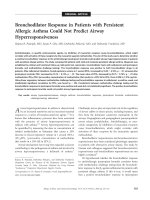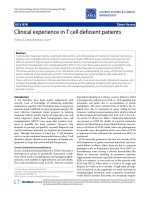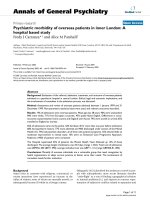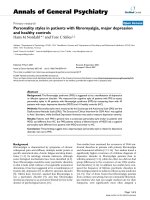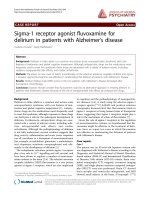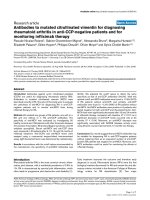Báo cáo y học: " Cheyne-Stokes respiration in patients hospitalised for heart failure" doc
Bạn đang xem bản rút gọn của tài liệu. Xem và tải ngay bản đầy đủ của tài liệu tại đây (277.98 KB, 7 trang )
BioMed Central
Page 1 of 7
(page number not for citation purposes)
Respiratory Research
Open Access
Research
Cheyne-Stokes respiration in patients hospitalised for heart failure
Lena Mared
1
, Charles Cline
2
, Leif Erhardt
2
, Søren Berg
3,4
and
Bengt Midgren*
1,4
Address:
1
Dept of Respiratory Medicine, University Hospital, Lund, Sweden,
2
Dept of Cardiology, University Hospital, Malmö, Sweden,
3
Dept of
ENT diseases, University Hospital, Lund, Sweden and
4
Lund Sleep Study Group, University Hospital, Lund, Sweden
Email: Lena Mared - ; Charles Cline - ; Leif Erhardt - ;
Søren Berg - ; Bengt Midgren* -
* Corresponding author
Abstract
Background: Previous studies showing a strong relationship between Cheyne-Stokes respiration
and the severity of left ventricular systolic dysfunction have usually been done in selected patient
populations with lower age and a higher proportion of males than the "typical" in-hospital patient
with heart failure. The purpose of the present study was test the strength of this relationship in
unselected patients admitted to hospital due to decompensated chronic heart failure.
Methods: We evaluated 191 patients (32% women), mean age 73 years, ready for discharge from
the heart failure unit in the University Hospital of Malmö, Sweden. The patients underwent
echocardiography for determination of left ventricular ejection fraction and left ventricular inner
diastolic diameter. A respiratory investigation during sleep was performed the last night before
discharge.
Results: We found that 66% of the patients had Cheyne-Stokes respiration more than 10% of the
total recording time. Only 7 (3.6%) of the patients had predominantly obstructive apnoeas. There
was a significant but very weak relationship between left ventricular ejection fraction and left
ventricular inner diastolic diameter on one hand and Cheyne-Stokes respiration on the other. Age
was a stronger determinant of Cheyne-Stokes respiration than any of the cardiac or other clinical
variables.
Conclusion: Although presence of Cheyne-Stokes respiration indicates left ventricular
dysfunction, its severity seems only weakly related to the severity of heart failure. Age was found
to be a stronger determinant, which may reflect the underlying age-dependency found also in
healthy subjects. Due to age restrictions or other selection criteria, the importance of age may have
been underestimated in many previous studies on factors associated with Cheyne-Stokes
respiration.
Background
Cheyne-Stokes respiration (CSR) during sleep, is com-
mon in patients with heart failure [1,2]. Cheyne-Stokes
respiration during sleep has been claimed to be an inde-
pendent risk factor for death [3,4], speculatively through
increased neurohumoral stress on the heart [5]. Results
from other studies have, however, been contradictory [6].
It has also been claimed that sleep disturbance from
Published: 20 September 2004
Respiratory Research 2004, 5:14 doi:10.1186/1465-9921-5-14
Received: 20 February 2004
Accepted: 20 September 2004
This article is available from: />© 2004 Mared et al; licensee BioMed Central Ltd.
This is an open-access article distributed under the terms of the Creative Commons Attribution License ( />),
which permits unrestricted use, distribution, and reproduction in any medium, provided the original work is properly cited.
Respiratory Research 2004, 5:14 />Page 2 of 7
(page number not for citation purposes)
Cheyne-Stokes respiration may cause daytime sleepiness
[7].
Most previous studies have included selected patients
with impaired left ventricular systolic function. A large
proportion of heart failure patients are elderly and have
relatively preserved left ventricular systolic function.
However, elderly heart failure patients have often been
excluded from sleep studies. Such studies are not repre-
sentative of the everyday clinical spectrum of heart failure
patients, including the increasing number of elderly
patients usually seen in general medical wards. The pro-
portion of women, with predominantly diastolic heart
failure, may also be greater in this group.
The aims of the present study were to test the strength of
the relationship between left ventricular dysfunction and
nocturnal Cheyne-Stokes respiration in unselected
patients admitted to hospital due to decompensated
chronic heart failure and to determine the correlation
between Cheyne-Stokes respiration and other clinical var-
iables to provide source material for subsequent analyses
of quality of life and survival.
Methods
Patients
All patients admitted to the Heart Failure Unit at the
Department of Cardiology, Malmö University Hospital
from January 1996 to november 1999 primarily due to
decompensated chronic heart failure were eligible for
inclusion. Malmö University Hospital serves as the main
hospital for the whole population of Malmö (population
250,000) and is the only hospital in the city. Patients were
excluded only if unable to comply to the study protocol
due to some other condition, to complete the study ques-
tionnaire or to provide informed consent. Heart failure
was diagnosed according to European Society of Cardiol-
ogy guidelines for the diagnosis of heart failure [8]. All
patients had been stabilised following treatment for heart
failure and were studied on the day prior to planned dis-
charge. For practical reasons not all patients discharged
could be included into the study. Patients were included
if they were to be discharged on a weekday and only when
a nurse trained in the use of the registration apparatus was
available. Furthermore, we could not register more than
one patient per night. Unfortunately, the precise number
of patients discharged alive from this unit during this par-
ticular period was not possible to obtain, but a crude esti-
mate is that we have investigated between 25 and 50% of
the available patients.
All patients provided informed consent to participate in
the study, which was performed in accordance with the
principles of the Declaration of Helsinki and approved by
the Medical Ethics Committee at Lund University.
Clinical evaluation
Ischaemic heart disease was diagnosed based on findings
from previous coronary angiography, documented myo-
cardial infarction or typical signs of ischaemia at exercise
testing. Hypertension (according to the local guidelines at
the time of the study) was diagnosed if blood pressure was
>150/95 mmHg or the patient was receiving drug therapy
for hypertension. Diabetes was diagnosed if fasting blood
glucose levels were >7 mmol/l or the patient was treated
with oral anti-glycaemic medication or insulin. The diag-
nosis of other concomitant diseases was based on patient
history and/or patient records.
Echocardiography
Echocardiographic examinations were performed using a
Hewlett-Packard Sonos 2000 (Andover, Mass, USA). Par-
asternal and apical views were obtained with the patient
in a left lateral recumbent position. Measurements were
acquired during silent respiration or end-expiratory
apnoea. Left ventricular systolic function was assessed by
determination of the mean left atrioventricular plane dis-
placement (AVPD), global qualitative assessment and/or
single plane ellipse (modified Simpson's rule) [9-11].
Respiration during sleep
We recorded oronasal airflow by thermocouples, electro-
cardiogram, chest wall movement by electrical imped-
ance, and finger pulse oximetry using the EdenTrace II
Plus Multirecording System (EdenTech Corp, Eden Prai-
rie, MN, USA) [12,13]. The recordings started when the
patients went to bed and were discontinued the following
morning when the patients woke up. No attempt was
made to define the amount of sleep. The recordings were
printed out and scored manually. Hypnotics were
allowed, and were taken by 48% of the patients at the time
of the study. Patients were considered to be habitual snor-
ers if they answered "often" or "always" to the question
"Do you snore loudly and disturbingly?"
Scoring and analysis of breathing patterns
The records were scored manually for Cheyne-Stokes res-
piration (gradual waxing and waning of respiration fol-
lowed by a central apnoea or hypopnoea) [14,15] and for
obstructive sleep apnoea. Patients with purely or predom-
inantly obstructive sleep apnoea (n = 7) were excluded
from the analyses of CSR. Patients with occasional
obstructive apnoeas occuring during extended periods of
CSR (n = 28) were included in the analyses of CSR. The
total time spent in Cheyne-Stokes respiration was divided
by the total recording time to compute the percentage of
time in bed spent in Cheyne-Stokes respiration (CSR%).
Since CSR% was not normally distributed, we used Spear-
mans rank correlation test to relate CSR% to the continu-
ous variables age, BMI, LVEF and LVIDD. For analysis of
Respiratory Research 2004, 5:14 />Page 3 of 7
(page number not for citation purposes)
CSR% with respect to the categorical variables gender, cer-
ebrovascular disease, ischaemic heart disease, NYHA class,
atrial fibrillation and habitual snoring, we used the Mann-
Whitney U-test.
There are no data in the literature to allow categorisation
of patients as normal and abnormal according to any spe-
cific level of CSR%. In table 2, the data concerning CSR%
are, however, categorised; this is for demonstrational pur-
pose only.
Results
Clinical data
Two hundred and three patients were included, however
final analysis only included 191 patients (32% women).
Three patients were excluded because of total recording
time less than two hours. Eight patients were excluded due
to the poor quality of their recordings and one patient was
excluded because of an abnormal irregular breathing pat-
tern that could not be categorized as Cheyne-Stokes or
obstructive sleep apnoea.
The aetiology of the heart failure was ischaemic heart dis-
ease in 60%, dilated cardiomyopathy in 3%, hypertension
in 14%, valvular disease in 8% and other or unknown rea-
son in 15%. Half of the patients had had heart failure
diagnosis for more than a year. All but eight patients were
prescribed diuretics, 43% digitalis, 70% ACE inhibitors
and 28% beta-blockers. Almost half (48%) of the patients
used hypnotics (usually bensodiazepines).
The clinical characteristics of the study patients are pre-
sented in Table 1. Five patients were in NYHA class 1, 83
in NYHA 2, 89 in NYHA 3 and five in NYHA 4. Only 10
patients were free from concomitant disease. Twenty five
percent had diabetes, 13% chronic obstructive pulmonary
disease and 18% cerebrovascular disease (reversible or
permanent cerebral ischaemia or haemorrhage) at any
time prior to the investigation. Five percent had cancer
diagnosed and treated within the last year.
Overall 26% had heart failure due to left ventricular
diastolic dysfunction (ejection fraction >45%). Female
patients were older (Table 1) and more likely to have
heart failure with preserved left ventricular systolic func-
tion; 36% had ejection fraction ≥45% as compared to
22% of the males (p < 0.05, chi square). There was no sig-
nificant gender difference in the prevalence of ischaemic
heart disease as the cause of heart failure.
Respiration during sleep
The average recording time was 424 (SD 75, median 444,
interquartile 400–472) minutes and average CSR% 35
(SD 30, median 28, interquartile 6–59). Predominantly
obstructive apnoeas were found in seven patients (3.7%)
and CSR (arbitrarily defined as CSR% >10%) in 126
patients (66%). Sixty (31%) of the patients had CSR more
than 50% of the recording time (Table 2). In figure 1, four
examples of different breathing patterns are
demonstrated.
Univariate rank correlation analysis showed that CSR%
was most strongly correlated to age (R = 0.24, p < 0.01, fig-
ure 2), but also to left ventricular ejection fraction (LVEF)
and to left ventricular diastolic diameter (table 2). Step-
wise multiple regression analysis with gender, age, BMI,
LVEF and LVIDD as independent variabels confirmed the
relative importance of age vs that of LVEF and LVIDD (r
2
0.06 vs 0.03 and 0.03). The severity of CSR was also
greater in patients with ischaemic heart disease. There
were no relationships between medication (e.g. betab-
lockers or benzodiazepines) and CSR%.
Seven patients (3.6%) were found to have predominantly
obstructive sleep apnoea (average AHI 16.0, SD 7.0,
median 16.2, interquartile range 8.7 – 21.8). Excessive
Table 1: Clinical characteristics of the study patients
All patients Females (n = 61) Males (n = 130) Significance
Age (years) 72. 6 ± 10.0 75.1 ± 8.9 71.4 ± 10.3 P < 0.05
BMI (kg/m
2
) 25.7 ± 4.6 25.4 ± 5.4 25.9 ± 4.3 NS
LVIDD (mm) 56.5 ± 9.4 51.2 ± 9.5 59.0 ± 8.3 P < 0.001
LVEF (%) 36.2 ± 12.1 39.0 ± 13.0 34.9 ± 11.6 P < 0.05
LVEF ≥45% (percentage of patients) 26 36 22 P < 0.05
Ischaemic heart disease (percentage of patients) 60 57 62 NS
NYHA 3–4 (percentage of patients) 52 57 49 NS
Atrial fibrillation (percentage of patients) 35 33 35 NS
Cerebrovascular disease (percentage of patients) 18 15 19 NS
Habitual snorers (percentage of patients) 12 7 15 P < 0.05
Values for continuous data (age, BMI, LVIDD and LVEF) are given as mean ± SD. Significance testing is made with T-test for continuous data and chi-
square for the other data.
Respiratory Research 2004, 5:14 />Page 4 of 7
(page number not for citation purposes)
snoring, obesity or male gender were not overrepresented
in this group.
Discussion
We have shown that CSR is common in elderly patients
hospitalised due to decompensated chronic heart failure
and that age was a stronger determinant of CSR than any
of the cardiac or other clinical variables
Selection of patients and timing of the study
Malmö University Hospital serves a population of
250,000 inhabitants. In general all patients primarily
Table 2: Cheyne-Stokes respiration related to physiologic variables
All CSR incl mixed apnoeas
CSR% CSR% CSR% Significance
<10 10–50 >50
n = 58 n = 66 n = 60
Age (years) 68.8 ± 11.7 72.1 ± 8.5 75,9 ± 8.6 p < 0.01
R=0.24
Body Mass Index (kg/m
2
) 26.5 ± 5.5 26.1 ± 4.3 24.6 ± 4.1 NS
LVEF (%) 36.1 ± 12.1 38.8 ± 12.6 32.4 ± 11.5 P < 0.05
R=-0.17
LVIDD (mm) 55.1 ± 10.0 57.1 ± 9.4 58.0 ± 8.2 P < 0.01
R = 0.20
Ischaemic heart disease (percentage of patients) 51 59 72 p < 0.05
NYHA class 3–4 (percentage of patients) 60 39 55 NS
Atrial fibrillation (percentage of patients) 29 33 40 NS
Cerebrovascular disease (percentage of patients) 16 11 27 NS
Habitual snorers (percentage of patients) 12 12 12 NS
Males (percentage of patients) 57 77 70 NS
Values are given as mean ± SD. Patients are divided according to the severity of Cheyne-Stokes respiration (quantified as percentage of total
recording time); the limits are arbitrarily chosen. Significance testing is made with Spearman's rank correlation test for continuous variables and
with Mann-Whitney U-test for categorical data.
Examples of nocturnal respiratory recordingsFigure 1
Examples of nocturnal respiratory recordings. The
upper part of each panel is the flow signal from the thermo-
couples and the lower is the impedance signal from the ECG
electrodes. The duration of each example is 6 minutes. Panel
A depicts an unequivocal period of Cheyne-Stokes respira-
tion. Panel B was interpreted as normal by the software of
the recording device, but was interpreted by us as Cheyne-
Stokes respiration. Panel C is an example of obstructive sleep
apnoeas and panel D is a period of Cheyne-Stokes respira-
tion with a small obstructive component, classified by us as
Cheyne-Stokes respiration rather than obstructive sleep
apnoeas.
Cheyne-Stokes respiration as a function of ageFigure 2
Cheyne-Stokes respiration as a function of age.
Cheyne-Stokes respiration (% of total recording time) as a
function of age, linear regression line and confidence bands
are drawn. Filled circles denote patients with LVEF 45 and
above, i.e. patients with diastolic heart failure.
Respiratory Research 2004, 5:14 />Page 5 of 7
(page number not for citation purposes)
admitted to hospital due to decompensated chronic heart
failure are treated at the Heart Failure Unit until discharge
from hospital. Due to this and to the liberal inclusion cri-
teria we believe that the study patients are representative
of the general population of patients with heart failure.
Many other studies suffer from the disadvantages of a
selection bias by excluding older patients, including only
men or including only patients specifically referred for
sleep studies [16] or for evaluation for heart transplanta-
tion [17].
One major difference between our study design and that
of the majority of other studies is that we included
patients immediately after an episode of decompensation,
whereas most other authors have studied patients 1–3
months after discharge. We do not, however, know to
what extent this approach affects nocturnal breathing pat-
terns. The results reported by Tremel et al [2] suggest that
sleep respiratory disturbances are stable during the second
month after an episode of worsening heart failure,
whereas there are no data, as far as we know, examining
patients prior to that phase. Nonetheless, many observa-
tions of apnoeas (by nurses and relatives, posing ques-
tions to the clinician) are made during the
hospitalisation. Our results are therefore relevant with
respect to the factors associated with apnoeas in this
situation.
Respiratory disturbances during sleep
At the time of the study, the most convenient and easy
manageable system available at our department was the
EdenTrace system. The semiquantitative nature of chest
wall impedance measurement may have reduced the sen-
sitivity of our measurements. However, by combining
impedance measurement of respiratory movements,
recording of oronasal airflow with thermocouples and
finger pulse oxymetry with a careful visual analysis af the
traces by an experienced physician (SB), we postulate that
the distinction between central and obstructive events is
sufficiently accurate. Furthermore that the bias intro-
duced, would tend to underestimate, rather than overesti-
mate the prevalence of sleep disordered breathing in the
studied population.
Whereas there are widely accepted standards for analysis
of sleep apnoea the definition of CSR is less precise, and
there is no accepted standard method for its quantifica-
tion. We quantified the severity of CSR as percentage of
total recording time. This approach is suggested by Ancoli-
Israel et al [14] and is accepted also by the American Acad-
emy of Sleep Medicine Task Force [15] since it is simple
and well suited for routine clinical use, irrespective of the
technical methods available for respiratory recordings.
The overall prevalence of CSR in this material was 66%,
using an arbitrary limit of CSR% >10%. This figure is in
the same magnitude as the 50–60% previously reported
in stable heart failure outpatients [18,19] and close to that
found by Ancoli-Israel (70%) in a small group of elderly,
hospitalised patients [14]. We suggest that the main cause
of the prevalence differences between studies is the age of
the population studied, rather than the timing with regard
to worsening heart failure [2].
We found 28 patients with mixed apnoeas (see figure 1
panel D for example). We believe that these patients
should be considered to have a variant of CSR rather than
to have an obstructive sleep apnoea syndrome (OSAS).
There was no excess of snoring, obesity or male gender in
this group, factors that are otherwise considered to be
associated with OSAS. Furthermore, exclusion of these
patients from the analyses did not change our results. It
has been suggested that obstructive sleep apnoeas and
CSR in heart failure patients both are part of a spectrum of
periodic breathing [20,21], our data are compatible with
this hypothesis.
Age
The most consistent result of our study is that age was
more strongly related to Cheyne Stokes respiration than
any other variable recorded. This corroborates data from
other large studies without an upper age limit [14,16,22].
Many other studies that failed to demonstrate a similar
relationship are constrained to patients below an arbitrary
age limit or to patients referred for cardiac transplantation
[17], which strongly affects validity for the general in-hos-
pital patients. The strength of the association with age
remained also when we excluded the youngest outliers
(see figure 2) from the statistical analysis. We therefore
consider our finding of age-dependency to be valid for
unselected in-hospital patients with heart failure. It
should be emphasized, however, that the predictive value
of age was very weak, only explaining 6% of the total
variability.
Increasing prevalence of central apnoeas with age in nor-
mal subjects has been demonstrated by e.g. Bixler and
coworkers [23], although the prevalence is much lower
than that found in our patients with heart failure. Bixler et
al suggest that a conservative approach should be applied
when interpreting sleep studies in elderly. Our data sug-
gest that this may also be a valid strategy for patients with
heart failure. Although the presence of CSR seems to be
associated with the presence of heart failure, its severity
gives little information about the severity of the heart
disease.
Respiratory Research 2004, 5:14 />Page 6 of 7
(page number not for citation purposes)
Gender
We found no gender effect (table 2), in contrast to the
findings of e.g. Sin and coworkers [16]. One important
reason may be that their 450 patients (only 15% women
vs 32% in our study) were not a random sample of heart
failure patients, but represent a much younger population
(mean age 60 years vs 72 in our study) specifically referred
for a sleep study.
Indices of heart failure
Heart dilatation (in our study measured as LVIDD) has
been claimed to be an important factor for the develop-
ment of CSR [24]. Impaired systolic function, as demon-
strated by a low LVEF, is another factor that is usually
considered to be associated with CSR. In our data, we
found that these factors explained only 3% each of the
variability of CSR. This contrasts to the results of many
other studies, but is well in accordance with the findings
of Sin and coworkers in their large study [16]. The idea of
CSR mainly being a function of low cardiac output (as
estimated by e.g. LVEF) may therefore be an
oversimplification.
Atrial fibrillation is a third factor that has been claimed to
be associated with CSR [16,18,22], but this could not be
confirmed in our study. One reason for the discrepancy
may be that the patients in the studies of Sin [16] and
Javaheri [18] were considerably younger than our
patients, with a lower prevalence of atrial fibrillation.
Thus their findings may have been confounded by an age
effect. However the study of Blackshear [22] with a non-
selected sample of elderly heart failure patients with a
high prevalence of atrial fibrillation demonstrates a strong
relationship between atrial fibrillation and CSR. The rea-
son for the discrepancy between their results and our
present study is not obvious.
Concomitant diseases
Patients with a history of stroke are usually excluded from
studies on CSR and heart failure. This may be a limitation
of the external validity of such studies, since many
patients with heart failure (18% in our material) also have
a history of minor or major cerebrovascular disease. We
found however, quite unexpectedly, that this was not
associated with a higher occurrence of CSR, thereby cor-
roborating the findings of Blackshear et al [22]. Neither
was any other concomitant disease associated with CSR.
There was no association between intake of hypnotics and
CSR.
Conclusions
Although presence of Cheyne-Stokes respiration indicates
presence of left ventricular dysfunction, its severity seems
only weakly related to severity of heart failure. Age was a
stronger determinant, which may reflect the underlying
age-dependency found also in healthy subjects. Follow-up
of the current patient cohort will be performed, but from
the present data, we cannot conclude if Cheyne-Stokes
respiration is of clinical importance or not.
Authors' contributions
LM coordinated and performed the study which was
designed by CC and BM. LE and CC were responsible for
the cardiac investigations and SB and BM for the interpre-
tation of the nocturnal respiratory recordings.
Acknowledgements
Financial support has in part been provided by the Swedish Heart and Lung
Foundation and by a research grant from Aga Gas AB, Sweden.
References
1. Javaheri S, Parker TJ, Wexler L, Michaels SE, Stanberry E, Nishyama
H, Roselle GA: Occult sleep-disordered breathing in stable
congestive heart failure. Ann Intern Med 1995, 122:487-492.
2. Tremel F, Pépin J-L, Veale D, Wuyam B, Siché J-P, Mallion JM, Lévy P:
High prevalence and persistence of sleep apnoea in patients
referred for acute left ventricular failure and medically
treated over 2 months. Eur Heart J 1999, 20:1201-1209.
3. Lanfranchi PA, Braghiroli A, Bosimini E, Mazzuero G, Colombo R,
Donner CF, Giannuzzi P: Prognostic value of nocturnal Cheyne-
Stokes respiration in chronic heart failure. Circulation 1999,
99:1435-1440.
4. Hanly PJ, Zuberi-Khokhar NS: Increased mortality associated
with Cheyne-Stokes respiration in patients with congestive
heart failure. Am J Respir Crit Care Med 1996, 153:272-276.
5. Köhnlein T, Welte T, Tan LB, Elliott MW: Central sleep apnoea
syndrome in patients with chronic heart disease: a critical
review of the current literature. Thorax 2002, 57:547-554.
6. Andreas S, Hagenah G, Möller C, Werner GS, Kreuzer H: Cheyne-
Stokes respiration and prognosis in congestive heart failure.
Am J Cardiol 1996, 78:1260-1264.
7. Hanly P, Zuberi-Khokhar N: Daytime sleepiness in patients with
congestive heart failure and Cheyne-Stokes respiration. Chest
1995, 107:952-958.
8. The Task Force on Heart Failure of the European Society of Cardiol-
ogy: Guidelines for the diagnosis of heart failure. Eur Heart J
1995, 16:741-751.
9. Alam M, Höglund C, Thorstrand C, Hellekant C: Hemodynamic
significance of the atrioventricular plane displacement in
patients with coronary disease. Eur Heart J 1992, 13:194-200.
10. Alam M, Höglund C, Thorstrand C: Longitudinal systolic shorten-
ing of the left ventricle: An echocardiographic study in sub-
jects with and without preserved global function. Clin Physiol
1992, 12:443-452.
11. Willenheimer R, Cline C, Erhardt L, Israelsson B: Left ventricular
atrioventricular plane displacement: An echocardiographic
technique for rapid assessment of prognosis in heart failure.
Heart 1997, 78:230-236.
12. Emsellem HA, Corson WA, Rappaport BA, Hackett S, Smith LG,
Hausfeld JN: Verification of sleep apnea using a portable sleep
apnea screening device. South Med J 1990, 83:748-752.
13. Redline S, Tosteson T, Boucher MA, Millman RP: Measurement of
sleep-related breathing disturbances in epidemiologic stud-
ies. Assessment of the validity and reproducibility of a port-
able monitoring device. Chest 1991, 100:1281-1286.
14. Ancoli-Israel S, Engler RL, Friedman PJ, Klauber MR, Ross PA, Kripke
DF: Comparison of patients with central sleep apnea. With
and without Cheyne-Stokes respiration. Chest 1994,
106:780-786.
15. American Academy of Sleep Medicine Task Force: Sleep-related
breathing disorders in adults: recommendations for syn-
drome definition and measurement techniques in clinical
research. Sleep 1999, 22:667-689.
16. Sin DD, Fitzgerald F, Parker JD, Newton G, Floras JS, Bradley TD:
Risk factors for central and obstructive sleep apnea in 450
Publish with BioMed Central and every
scientist can read your work free of charge
"BioMed Central will be the most significant development for
disseminating the results of biomedical research in our lifetime."
Sir Paul Nurse, Cancer Research UK
Your research papers will be:
available free of charge to the entire biomedical community
peer reviewed and published immediately upon acceptance
cited in PubMed and archived on PubMed Central
yours — you keep the copyright
Submit your manuscript here:
/>BioMedcentral
Respiratory Research 2004, 5:14 />Page 7 of 7
(page number not for citation purposes)
men and women with congestive heart failure. Am J Respir Crit
Care Med 1999, 160:1101-1106.
17. Mortara A, Sleight P, Pinna GD, Maestri R, Capomolla S, Febo O, La
Rovere MT, Cobelli F: Association between hemodynamic
impairment and Cheyne-Stokes respiration and periodic
breathing in chronic stable congestive heart failure second-
ary to ischemic or idiopathic dilated cardiomyopathy. Am J
Cardiol 1999, 84(8):900-904.
18. Javaheri S, Parker TJ, Liminy JD: Sleep apnea in 81 ambulatory
male patients with stable heart failure: types and their prev-
alences, consequences, and presentations. Circulation 1998,
97:2154-2159.
19. Staniforth AD, Kinnear WJM, Starling R, Cowley AJ: Nocturnal
desaturation in patients with stable heart failure. Heart 1998,
79:394-399.
20. Alex CG, Önal E, Lopata M: Upper airway occlusion during sleep
in patients with Cheyne-Stokes respiration. Am Rev Respir Dis
1986, 133:42-45.
21. Tkacova R, Niroumand M, Lorenzo-Filho G, Bradley TD: Overnight
shift from obstructive to central apneas in patients with
heart failure. Role of PCO2 and circulatory delay. Circulation
2001, 103:238-243.
22. Blackshear JL, Kaplan J, Thompson RC, Safford RE, Atkinson EJ: Noc-
turnal dyspnea and atrial fibrillation predict Cheyne-Stokes
respirations in patients with congestive heart failure. Arch
Intern Med 1995, 155:1297-1302.
23. Bixler EO, Vgonzas AN, Ten Have T, Tyson K, Kales A: Effects of
age on sleep apnea in men. 1. Prevalence and severity. Am J
Respir Crit Care Med 1998, 157:144-148.
24. Tkacova R, Hall MJ, Liu PP, Fitzgerald FS, Bradley TD: Left ventricu-
lar volume in patients with heart failure and Cheyne-Stokes
respiration during sleep. Am J Respir Crit Care Med 1997,
156:1549-1555.


